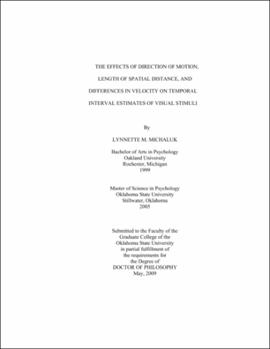Effects of direction of motion, length of spatial distance, and differences in velocity on temporal interval estimates of visual stimuli
| dc.contributor.advisor | Thomas, David G. | |
| dc.contributor.author | Michaluk, Lynnette Marie | |
| dc.date.accessioned | 2013-11-26T08:27:43Z | |
| dc.date.available | 2013-11-26T08:27:43Z | |
| dc.date.issued | 2009-05 | |
| dc.identifier.uri | https://hdl.handle.net/11244/6963 | |
| dc.description.abstract | Scope and Method of Study: The vast majority of psychophysical research involving velocity, distance, and duration fails to take into account the effects of each of these dimensions on the perception of the others. In this paper, this issue will be discussed and a study examining this problem presented. Aspects considered in this study included the examination of the combined effects of changes in velocity, length of spatial distance, and direction of motion on estimates of brief temporal intervals paired with visual stimuli. Previous research suggests that the direction of presentation of visual stimuli (i.e. top-to-bottom or bottom-to-top) should alter the perception of intervals so that intervals presented from top-to-bottom are perceived as taking less time than equal temporal intervals presented from bottom-to-top (Cohen, Hansel, & Sylvester, 1955; Hubbard, 1990; 1997; Hubbard & Bharucha, 1988; Hubbard & Motes, 2002). In addition, velocity of visual stimuli has also been shown to affect temporal intervals, such that faster velocities are associated with a subjective shortening of duration (Algom & Cohen-Raz, 1987). Finally, differences in length of spatial distances have also been shown to affect perceived duration, and when equal durations are paired with different distances, longer distances are judged as longer in duration as well (Abe, 1935; Adkins, 1972; Cohen & Cooper, 1962; Cohen et al., 1955; Huang & Jones, 1982; Ono, 1966-67; 1976; Ono & Maruyama, 1969-70; Parks, 1967; Price-Williams, 1954; Yoblick & Salvendy, 1970). To date, there is no research examining the influence of these factors in combination on estimates of temporal intervals. Therefore, in this study, each of these variables was systematically manipulated to more closely examine their combined effects on temporal estimates. | |
| dc.description.abstract | Findings and Conclusions: Results indicated that in the current study, temporal intervals were perceived as shorter when presented from top-to-bottom, but were not perceived as longer when presented from bottom-to-top. Furthermore, distance and velocity interacted in such a manner as to lead to a perceived shortening of temporal interval presented from top-to-bottom when distance was long and velocity was fast. Future research in the area is suggested. | |
| dc.format | application/pdf | |
| dc.language | en_US | |
| dc.rights | Copyright is held by the author who has granted the Oklahoma State University Library the non-exclusive right to share this material in its institutional repository. Contact Digital Library Services at lib-dls@okstate.edu or 405-744-9161 for the permission policy on the use, reproduction or distribution of this material. | |
| dc.title | Effects of direction of motion, length of spatial distance, and differences in velocity on temporal interval estimates of visual stimuli | |
| dc.contributor.committeeMember | Ackerson, Bruce J. | |
| dc.contributor.committeeMember | Chaney, John M. | |
| dc.contributor.committeeMember | Page, Melanie C. | |
| osu.filename | Michaluk_okstate_0664D_10301.pdf | |
| osu.accesstype | Open Access | |
| dc.type.genre | Dissertation | |
| dc.type.material | Text | |
| dc.subject.keywords | intuitive physics | |
| dc.subject.keywords | motion | |
| dc.subject.keywords | representational momentum | |
| dc.subject.keywords | spatial distance | |
| dc.subject.keywords | temporal estimates | |
| dc.subject.keywords | velocity | |
| thesis.degree.discipline | Psychology | |
| thesis.degree.grantor | Oklahoma State University |
Files in this item
This item appears in the following Collection(s)
-
OSU Dissertations [11222]
